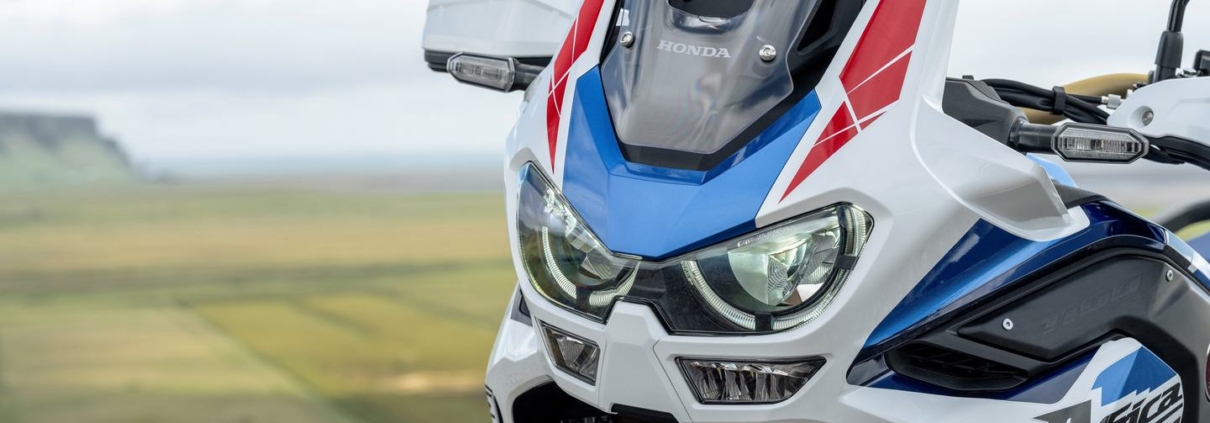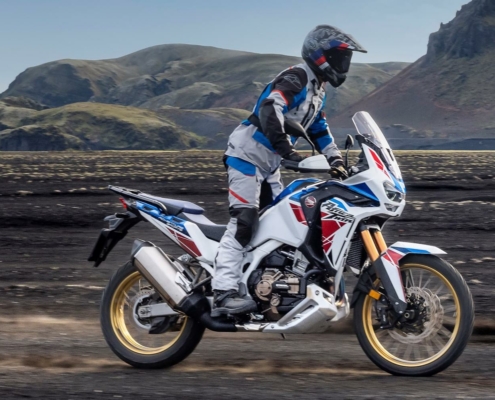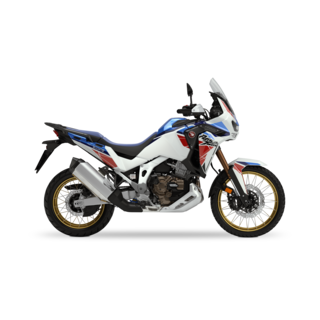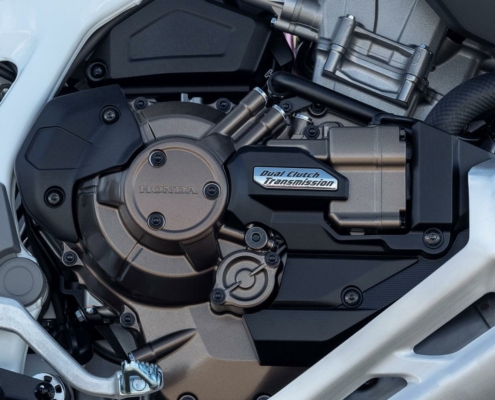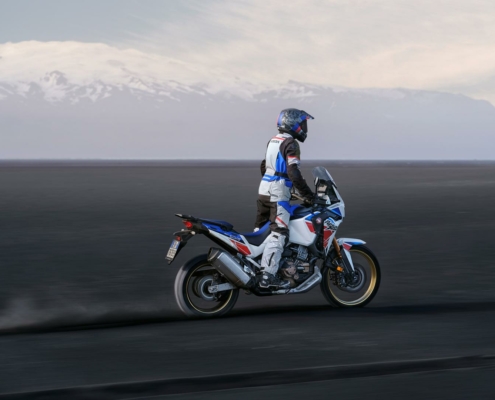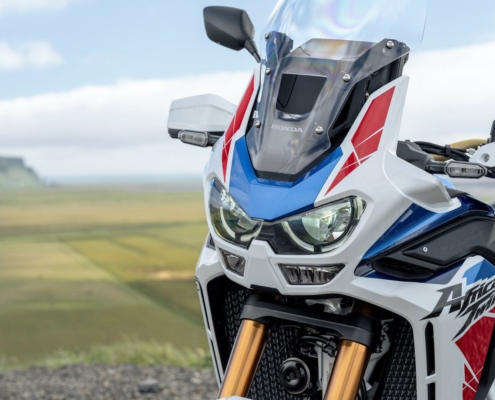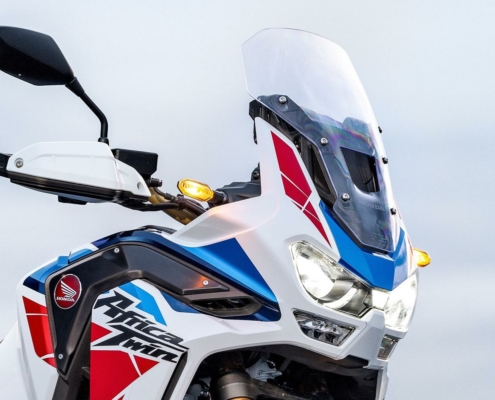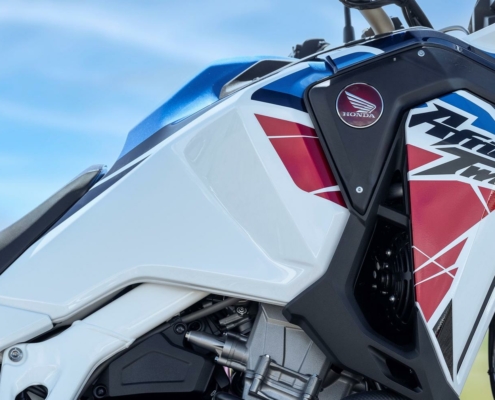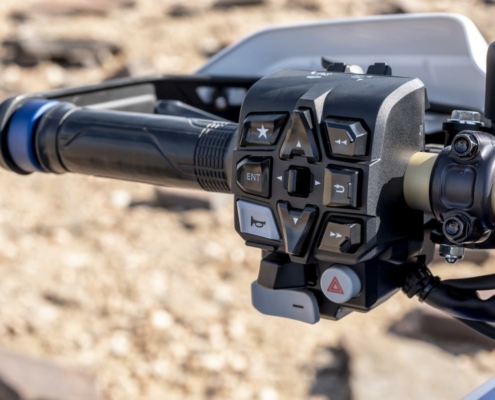CRF1100D2 AFRICA TWIN ADVENTURE SPORTS ABS – DCT
- Automatic dual clutch transmission (DCT)
- Large 24.8L fuel tank
- Large adjustable windscreen
- Tubeless tyres
- Heated grips
Serious off-road performance, lightweight chassis with slim bodywork and a characterful, torque-heavy engine. These are the fundamentals that made the Africa Twin one of the most popular adventure tourers in the world. Combined with the latest technology including riding modes, HSTC, wheelie and rear lift control, and packaged in an unique, aggressive and compact rally-style design.
FEATURES
AT A GLANCE
Off-road ready
Compact body style, slim seat and high handlebars
High performance
Unicam design 1084cc twin-cylinder engine delivers plenty of power and torque all through the rev range
Added safety
Honda Selectable Torque Control (HSTC), selectable ABS with cornering technology
Advanced technology
Multiple riding modes, cruise control, 6-axis inertial measurement unit (IMU) controlled ABS and HSTC, Apple CarPlay™, Android Auto
Cornering lights
Large adjustable screen
Large 24.8L fuel tank
Heated grips
Dual Clutch Transmission (DCT)
• Super-fast gear changes in either Manual Transmission (MT) or Automatic D and S modes
• S mode (with 3 levels) revs higher and downshifts sooner than D, for more aggressive riding
• G switch improves rear wheel traction when off-road
• Incline detection adapts shift pattern depending on gradient
• IMU allows corning detection function for improved shift timings
Honda has sold over 100,000 DCT-equipped motorcycles across Europe since the system first appeared as an option on the VFR1200F a decade ago in 2009. Testament to its acceptance in the marketplace, during the last financial year, DCT accounted for 48% of European sales on models where DCT was an option.
The unique DCT system delivers consistent, super-fast seamless gear changes, and very quickly becomes second nature in use. It uses two clutches: one for start-up and 1st, 3rd and 5th gears: the other for 2nd, 4th and 6th, with the mainshaft for each clutch located inside the other for compact packaging.
Each clutch is independently controlled by its own electro-hydraulic circuit. When a gear change occurs, the system pre-selects the target gear using the clutch not currently in use. The first clutch is then electronically disengaged as, simultaneously, the second clutch engages.
The result is a consistent, fast and seamless gear change. Furthermore, as the twin clutches transfer drive from one gear to the next with minimal interruption of the drive to the rear wheel, any gear change shock and pitching of the machine is minimised, making the change feel direct as well as smooth.
The extra benefits of durability (as the gears cannot be damaged by missing a gear) impossibility of stalling, low stress urban riding and reduced rider fatigue add to DCT’s appeal
Three modes of operation are available. MT mode gives full manual control, allowing the rider to shift with the handlebar trigger control buttons. Automatic D mode is ideal for city and highway riding, and achieves optimum fuel efficiency. Automatic S mode offers three levels of sportier riding, as the ECU lets the engine rev a little higher before shifting up, and shifts down sooner when decelerating for extra engine braking.
In either D or S mode, DCT offers immediate manual intervention if required – the rider simply selects the required gear using the up and down shift triggers on the left handlebar. At an appropriate time, DCT seamlessly reverts back to automatic mode, depending on throttle angle, vehicle speed and gear position.
DCT for the Africa Twin is also fully equipped to operate in an adventure environment, with off-road functionality enhanced by the G switch accessed via the TFT touch screen display. Activating the G switch in any riding mode improves the feel for available traction and machine control by reducing the amount of clutch slip during gear changes.
Further functionality for the DCT system comes in the form of incline detection, by means of which the gear shift pattern is adapted depending on the grade of an incline to provide optimum control.
A new feature for the CRF1100L Africa Twin Adventure Sports’ DCT system is cornering detection. When the IMU recognises the bike is cornering, the system subtly adjusts the shifting programme for the most natural gear changes.
Engine
• Capacity rises to 1,084cc
• Achieved through a new cylinder head, valve timing and lift, throttle body and exhaust
• Manual transmission ratios and gear material optimised, saving weight
• The muffler now features a variable Exhaust Control Valve (ECV) for improved low-rpm sound and high-rpm performance
The SOHC 8-valve parallel-twin engine has a larger displacement of 1,084cc, up from 998cc and as a result, the obvious increase in both power and torque makes itself felt from 2,500rpm all the way through to the redline.
To create the larger capacity, bore remains 92mm but stroke is longer at 81.5mm (from 75.1mm) with compression ratio of 10.1:1. The cylinder sleeves are also now aluminium. Along with other detailed weight savings in the transmission and elsewhere the manual transmission engine is now 2.5kg lighter (at 66.4kg) than the previous design, the DCT version 2.2kg lighter at 74.9kg.
As before, the 270° phased crankshaft and uneven firing interval create the engine’s distinctive throb and feel for rear wheel traction. The cylinder head however is completely revised, as is the larger diameter 46mm throttle body; the bore and cylinder pitches are also now aligned to create a smooth air intake profile. The ECU setting is new and the injector angle has been modified to deliver a more direct spray into re-shaped twin-spark combustion chambers.
Honda’s SOHC Unicam valve train is a feature of the MX competition-specification CRF450R and the low-set position of the cast camshaft contributes to the compact nature of the cylinder head. For 2020 the valve timing has been optimised and inlet and exhaust valve lift increased to 10.1mm inlet and 9.3mm exhaust (from 9.2/8.6mm).
To match and deal with the uprated intake efficiency and higher output (thus gas flow) the exhaust end-can now features a variable Exhaust Control Valve (ECV) very similar to the unit fitted to the CBR1000RR Fireblade. It enhances both engine performance and efficiency as it opens at higher rpm and gives a pleasing exhaust note ‘pulse’ at lower rpm.
The crankcases are split vertically; the water pump is housed efficiently within the clutch casing with a thermostat integrated into the cylinder head. Manual and DCT versions of the engine share common crankcases with only minor external differences; the water and oil pumps are both driven by the engine’s balancer shafts.
It’s a semi-dry sump design with in-tank lower crankcase oil storage. This allows a lower pan depth, keeping overall engine height low. As the pressure-fed pump is located within the tank where it delivers its oil from, there is no need for a pressure-feed passage. Secondary vibrations are neutralised by the mutually reciprocating motion of the pistons, while primary inertial and coupling vibrations are cancelled by the use of biaxial balance shafts.
For 2020 precision of the front and rear balance gears has been improved, allowing removal of their scissor gears; the addition of a crank pulsar ring adds misfire detection. In addition the 02 lambda exhaust sensors have been replaced with Linear Air Fuel (LAF) sensors in the downpipes to allow for much more accurate measurement of the air/fuel mixture ratio.
The aluminium clutch centre and pressure plate use ‘assist’ cams to ease upshifts and ‘slipper’ cams for deceleration and downshifting; the clutch diameter is now smaller and features reduced spring tension for lighter lever feel. The gears are also re-shaped and constructed from stronger material. A quickshifter remains available as an optional extra.
Electronics
• IMU-managed HSTC intervention levels optimised for off-road use
• Wheelie Control features 3 levels and IMU management
• OFF-ROAD joins the default riding modes TOUR, URBAN and GRAVEL
• Two USER modes allow for complete riding modes customisation
The Africa Twin’s engine received the benefits of Throttle By Wire (TBW) control in 2018, allowing much finer management of engine output and character as well as expanded Honda Selectable Torque Control (HSTC) for rear tyre grip.
For 2020 the system has smartly evolved and now works in conjunction with a six-axis IMU. At the very heart of the Africa Twin’s elevated on- and off-road performance is a Bosch MM7.10 six-axis Inertial Measurement Unit (IMU) tucked away at the centre of the machine, that measures – in real-time – roll angle/rate, pitch angle/rate and yaw angle/rate. It manages rear wheel traction via TBW and HSTC, front braking grip through Cornering ABS, front wheel lift through Wheelie Control and also adds Rear Lift Control.
The system offers 4 levels of power and 3 levels of engine braking. There are still seven levels of HSTC but each level’s amount of intervention has been optimised to work with real-time input (yaw/roll angle and rate) from the IMU. The spacing of the levels has been optimised to allow the rider a finer choice of the amount of rear tyre slide for off-road riding. HSTC can also be turned off completely.
Wheelie Control is another new feature. Again, with the IMU measuring pitch angle and rate, and controlling engine torque via TBW, the rider can choose between 3 levels of input. Level 1 allows for intended wheel lift but suppresses any sudden movement. Level 3 stops any front wheel elevation and level 2 is mid-way between the two. Wheelie Control can also be turned off completely.
There are four default riding mode settings: TOUR, URBAN, GRAVEL and OFF-ROAD to cover most riding conditions and situations plus two customisable USER settings. Even within the default riding modes, it’s possible to change some parameters – HSTC between levels 1-7 (plus off), Wheelie Control between levels 1-3 (plus off) and DCT S mode shift pattern levels 1-3.
TOUR employs the highest level of Power (1), for touring loaded with pillion and luggage plus mid-range Engine Braking (2) with active on-road Cornering ABS.
URBAN suits wide-ranging riding requirements and uses mid-level Power (2) and Engine Braking (2) with active on-road Cornering ABS.
GRAVEL delivers the lowest level of Power (4) and Engine Braking (3). Cornering ABS is active with an off-road setting; in this setting, the rear brake ABS cannot be switched off.
OFF-ROAD uses lower-mid level Power (3) and the lowest amount of Engine Braking (3). Cornering ABS is active with an off-road setting; the rear brake ABS can be switched off.
USER 1 & 2 modes offer the rider a choice of two distinct personalized setups – choosing between Power levels 1-4 and Engine Braking 1-3, ABS (on-road/off-road) and the damping and pre-load of the electronic suspension
Chassis
• Six-axis Inertial Measurement Unit located in the centre of the machine
• Showa Electronically Equipped Ride Adjustment now an option
• Revised, lighter frame with bolt-on aluminium subframe
• Cornering ABS provides sure-footed braking and features an off-road setting
• New damping and spring rates for the standard Showa suspension
• Tubeless tyres make for easy roadside repairs
In conjunction with the addition of IMU control for its 2020 evolution the strength and rigidity balance of the steel semi-double cradle frame was completely re-examined by Honda’s development engineers to reinforce its all-round ability on- and off-road.
Rigidity around the steering head has been optimised to enhance feel for front end grip; the main spars are also slimmer and straighter and do away with the front cross pipe. Frame weight is 1.8kg lighter than before.
A bolt-on aluminium subframe replaces the integral steel structure of the previous design and is 40mm slimmer at a width of 195mm – crucial for easier ground reach. The Monoblock aluminium swingarm is all-new, 500g lighter and based on the same design used by the CRF450R. Its improved rigidity improves rear wheel traction and rider feel.
To tailor damping force front and rear – and spring preload to suit load and riding conditions – Showa Electronically Equipped Ride Adjustment is available in Australia on one of the Africa Twin Adventure Sports variants.
Showa EERA™ adjusts damping force relative to riding mode selected and aims to deliver high-quality suspension reaction in diverse and opposite conditions – riding comfort at slower speeds and stability at higher speeds.
Input is gathered from stroke sensors plus Inertial Measurement Unit (IMU). There are three road settings: SOFT has the lowest damping force for smoothest reaction, versatile MID operates as an all-round setting with HARD, using the highest damping force through low-to-high stroke speed, designed for sportier riding.
There is an OFF-ROAD setting that gradually raises front fork damping force as stroke speed rises and uses higher damping settings for the rear shock.
Rear spring preload can be electronically adjusted while stationary, through four default settings; 1) riding solo, 2) riding solo with luggage, 3) riding two-up and 4) riding two-up with luggage. A USER option allows for fine-tuning of damping force front and rear and 24 points of rear spring preload.
The Africa Twin Adventure Sports Manual and DCT variants offer standard Showa suspension. With stroke length of 230mm, the 45mm cartridge-type inverted front fork offers long-travel bump absorption and features revised internal settings to improve all-round performance. Rebound and compression damping are fully adjustable. A cast aluminium top yoke and forged bottom yoke – joined by hollow aluminium stem shaft – clamp the fork legs with two bolts each top and bottom.
Similarly revised to match the front suspension, the rear shock delivers 220mm axle travel and features a 46mm cylinder and remote reservoir for stable damping control under extreme off-road riding conditions. Spring preload can be adjusted via a dial on the shock body; rebound and compression damping are also fully adjustable. The swingarm pivot points’ inner plates now use 600MPa high-strength steel and the upper cross tube that connects them acts as the rear shock upper mount through a pillow-ball joint.
The IMU takes in lean angle, deceleration (from front/rear wheel speed sensors) and incorporates the slip rate of the front and rear wheels to manage braking pressure through the ABS. Likewise if it detects sudden rear wheel lift, it finely controls brake force to maintain stability. When stationary the rear ABS can be cancelled for off-road riding.
Ground clearance remains 250mm, with wheelbase of 1575mm and rake and trail of 27.5° /113mm. Wet weight has been reduced by 5kg on the Manual version to 238kg, with DCT at 248kg. The Showa EERATM variant adds a further 2kg.
As before compact two-piece radial-mount four-piston calipers work dual 310mm ‘wave’ floating discs through sintered pads. The rear 256mm ‘wave’ disc features hole punching and shaping.
To make puncture repair easier when on tour the 21/18-inch front and rear (stainless steel) spoked wheels wear tubeless Bridgestone Battlax Adventurecross Tourer AX41T or Metzeler Karoo Street tyres, sized 90/90-21M/C 54H and 150/70R18 M/C 70H. Block pattern tyres (Continental 90/90-21M/C 54S and 150/70B 18M/C 70Q are also approved for fitment.
Styling & Equipment
• Protective bodywork, height-adjustable screen and lower seat height
• 24.8L fuel tank, aluminium insert panels, rear rack and engine bash plate
• Daytime Running Lights (DRL) with additional Cornering Lights • Cruise control, heated grips and ACC charger
• Multi Information Display (MID) 6.5-inch TFT touch screen
• Apple CarPlay® allows use of Apple iPhone® through the MID plus Bluetooth connectivity
Designed for the long-haul, the expanded front fairing offers plenty of wind and weather protection, multiplied by the 5-level height adjustable screen. The Africa Twin Adventure Sports now shares its seat height with the Africa Twin at 850-870mm (down considerably from the 900-920mm of the previous model).
The tail section is slimmer and the seat itself is 40mm narrower, for easier ground reach; its shape has also been carefully contoured to allow easier back and forth movement. Low 825-845mm and high 875-895mm seat options are available as accessories.
The riding triangle is now common with the Africa Twin itself, giving an upright riding position and comfortable control. Large knuckle guards are standard, as are heated grips and ACC charger.
Holding 24.8L, the fuel tank offers a potential range of over 500km, thanks to fuel economy of 4.8L/100km (20.4km/L, WMTC mode). A large engine sump guard, aluminium insert panels and an aluminium rear carrier are included in the specification.
The new dual LED headlights deliver a penetrating beam and, for additional security, feature three-stage right/left Cornering Lights that use speed and lean angle (controlled by the IMU) to automatically adjust the area illuminated when cornering. Daytime Running Lights (DRL) also automatically adjust to ambient light intensity and give a bright, highly visible light at all times.
The full colour Multi Information Display (MID) 6.5-inch TFT touch screen keeps the rider in control of all of the Africa Twin’s systems and each of the riding modes¬ are selected through the top left of the screen. The MID can also be customised to show various levels of information relative to the riding mode chosen, and is easy to use even when wearing gloves.
It also has Apple CarPlay® allowing use of an Apple iPhone® through the touchscreen. Navigation apps can also be accessed and displayed and via a Bluetooth helmet headset calls can be made or received. The iPhone® itself plugs into a USB charging port on the right of the MID. Hands-free wireless Bluetooth connectivity is also an option for an iPhone® or Android device and all control inputs are made from the left-hand switchgear.
The front and rear indicators have an Emergency Stop Signal function. When braking suddenly over 50kph the hazard lights flash to warn other road users a hard stop is in process. They also auto-cancel; rather than using a simple timer, the system compares front and rear wheel speed difference and calculates when to cancel the indication relative to the situation.
For 2020 cruise control is now fitted as standard, to ease long-distance highway travel.
Accessories
The range of Honda Genuine Accessories for the Africa Twin Adventure Sports has been expanded with luggage options that includes premium 42L aluminium top box and panniers plus large (58L) plastic top box and panniers, two seat heights (a lower 825-845mm and taller 870-895mm option), screen extender and deflector set, 4.5L tank bag, side tank pads, engine guards, side pipes and LED fog lights and centre stand.

